Submitted by chandra on Tue, 2010-12-14 12:34

This colorful creation was made by combining data from two of NASA's Great Observatories. Optical data of SNR 0509-67.5 and its accompanying star field, taken with the Hubble Space Telescope, are composited with X-ray energies from the Chandra X-ray Observatory. The result shows soft green and blue hues of heated material from the X-ray data surrounded by the glowing pink optical shell which shows the ambient gas being shocked by the expanding blast wave from the supernova. Ripples in the shell's appearance coincide with brighter areas of the X-ray data.
http://www.chandra.harvard.edu/photo/2010/snr0509/
-Megan Watzke
Submitted by chandra on Mon, 2010-11-15 11:00
This composite image shows a supernova within the galaxy M100 that may contain the youngest known black hole in our cosmic neighborhood. In this image, Chandra's X-rays are colored gold, while optical data from ESO's Very Large Telescope are shown in yellow-white and blue, and infrared data from Spitzer are red. The location of the supernova, known as SN 1979C, is labeled (roll your mouse over the image above).
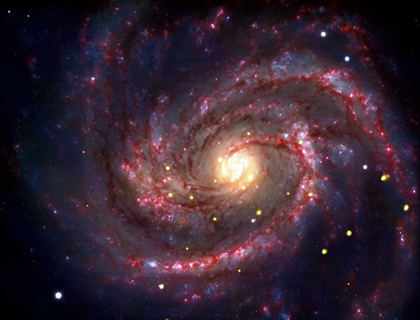
Submitted by chandra on Tue, 2010-10-05 23:37
G327.1-1.1 is the aftermath of a massive star that exploded as a supernova in the Milky Way galaxy. A highly magnetic, rapidly spinning neutron star called a pulsar was left behind after the explosion and is producing a wind of relativistic particles, seen in X-rays by Chandra and XMM-Newton (blue) as well as in the radio data (red and yellow). This structure is called a pulsar wind nebula. The likely location of the spinning neutron star is shown in the labeled version. The large red circle shows radio emission from the blast wave, and the composite image also contains infrared data from the 2MASS survey (red, green, and blue) that show the stars in the field.
Submitted by chandra on Mon, 2010-05-24 10:07
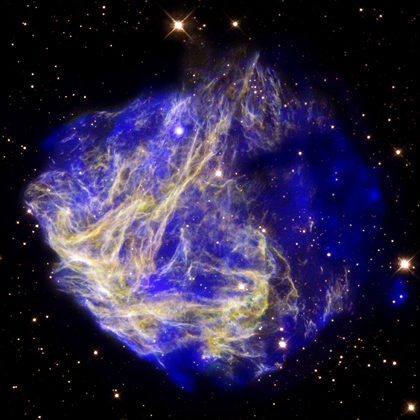
This beautiful composite image shows N49, the aftermath of a supernova explosion in the Large Magellanic Cloud. A new long observation from NASA's Chandra X-ray Observatory, shown in blue, reveals evidence for a bullet-shaped object being blown out of a debris field left over from an exploded star.
Submitted by chandra on Thu, 2010-03-25 13:16
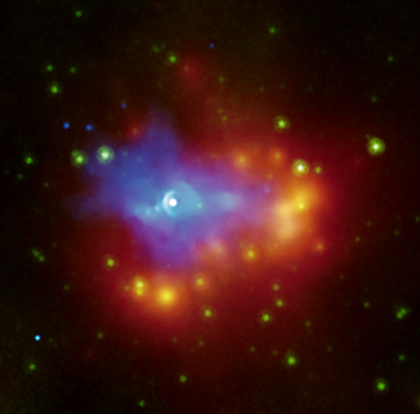
A new image from NASA's Chandra X-ray Observatory and Spitzer Space Telescope shows the dusty remains of a collapsed star. The dust is flying past and engulfing a nearby family of stars. Scientists think the stars in the image are part of a stellar cluster in which the a supernova exploded. The material ejected in the explosion is now blowing past these stars at high velocities.
Submitted by chandra on Thu, 2009-12-17 14:07
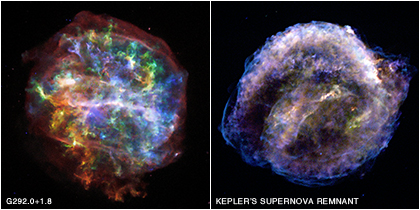
These two supernova remnants are part of a new study from NASA's Chandra X-ray Observatory that shows how the shape of the remnant is connected to the way the progenitor star exploded. In this study, a team of researchers examined the shapes of 17 supernova remnants in both the Milky Way galaxy and a neighbor galaxy, the Large Magellanic Cloud.
Submitted by chandra on Mon, 2009-11-23 11:13
Submitted by chandra on Wed, 2009-11-04 09:43
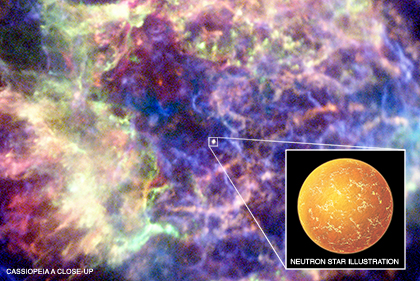
This Chandra X-ray Observatory image shows the central region of the supernova remnant Cassiopeia A (Cas A, for short) the remains of a massive star that exploded in our galaxy. Evidence for a thin carbon atmosphere on a neutron star at the center of Cas A has been found. Besides resolving a ten-year-old mystery about the nature of this object, this result provides a vivid demonstration of the extreme nature of neutron stars. An artist's impression of the carbon-cloaked neutron star is also shown.
Submitted by chandra on Thu, 2009-07-23 09:30
This image of the debris of an exploded star - known as supernova remnant 1E 0102.2-7219, or "E0102" for short - features data from NASA's Chandra X-ray Observatory. E0102 is located about 190,000 light years away in the Small Magellanic Cloud, one of the nearest galaxies to the Milky Way. It was created when a star that was much more massive than the Sun exploded, an event that would have been visible from the Southern Hemisphere of the Earth over 1000 years ago.
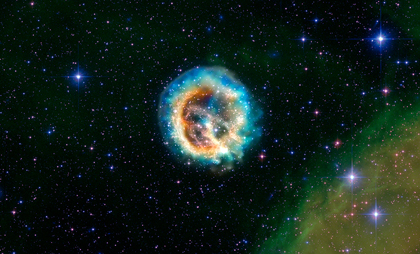
Submitted by chandra on Tue, 2009-06-30 09:21
This image of data from NASA's Chandra X-ray Observatory and the European Southern Observatory's Very Large Telescope shows a part of the roughly circular supernova remnant known as RCW 86. This remnant is the remains of an exploded star, which may have been observed on Earth in 185 AD by Chinese astronomers. By studying this remnant, a team of astronomers was able to understand new details about the role of supernova remnants as the Milky Way's super-efficient particle accelerators.
Pages